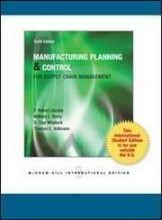Sequencing and scheduling
5 important questions on Sequencing and scheduling
Describe why scheduling a optimization problem is.
- Decisions: for every operation/ job:
• On what machine,
• Start times of the operations (--> end times, order)
- Objective: several choices, depending on the production strategy
- Constraints:
• Capacity constraints of the machines
• Operations cannot overlap
• (operations cannot be interrupted)
Describe what KPI's the SPT (priority rule: shortest processing time first) for basic single - machine scheduling problem minimizes.
- Average number of jobs in system J
- Average waiting time W
- Average lateness L
- Max. waiting time Wmax
Explain the effect of priority rule earliest due date (EDD) on the basic single-machine scheduling problem.
- Maximum lateness Lmax and
- Maximum tardiness Tmax
If the objective is to minimize the number of tardy jobs:
- If EDD leads to a schedule with no tardy jobs, the schedule is an optimal schedule, otherwise you can use (Moore-) Hodgson's algorithm to make an optimal schedule.
- Higher grades + faster learning
- Never study anything twice
- 100% sure, 100% understanding
Explain how to use Johnson's rule.
S1: All jobs for which the processing time on m1 is smaller than the processing time on m2.
S2: all other jobs.
- Put the jobs of S1 in the order in which the processing times on machine 1 are non-decreasing.
- Sequence the jobs of S2 in the order in which processing times on machine 2 are non-increasing.
- An optimal order is the ordered set S1, followed by the ordered set S2.
Why is solving an (M)ILP so difficult?
- Exact methods (may take long): cutting planes, branch and bound
The question on the page originate from the summary of the following study material:
- A unique study and practice tool
- Never study anything twice again
- Get the grades you hope for
- 100% sure, 100% understanding






























